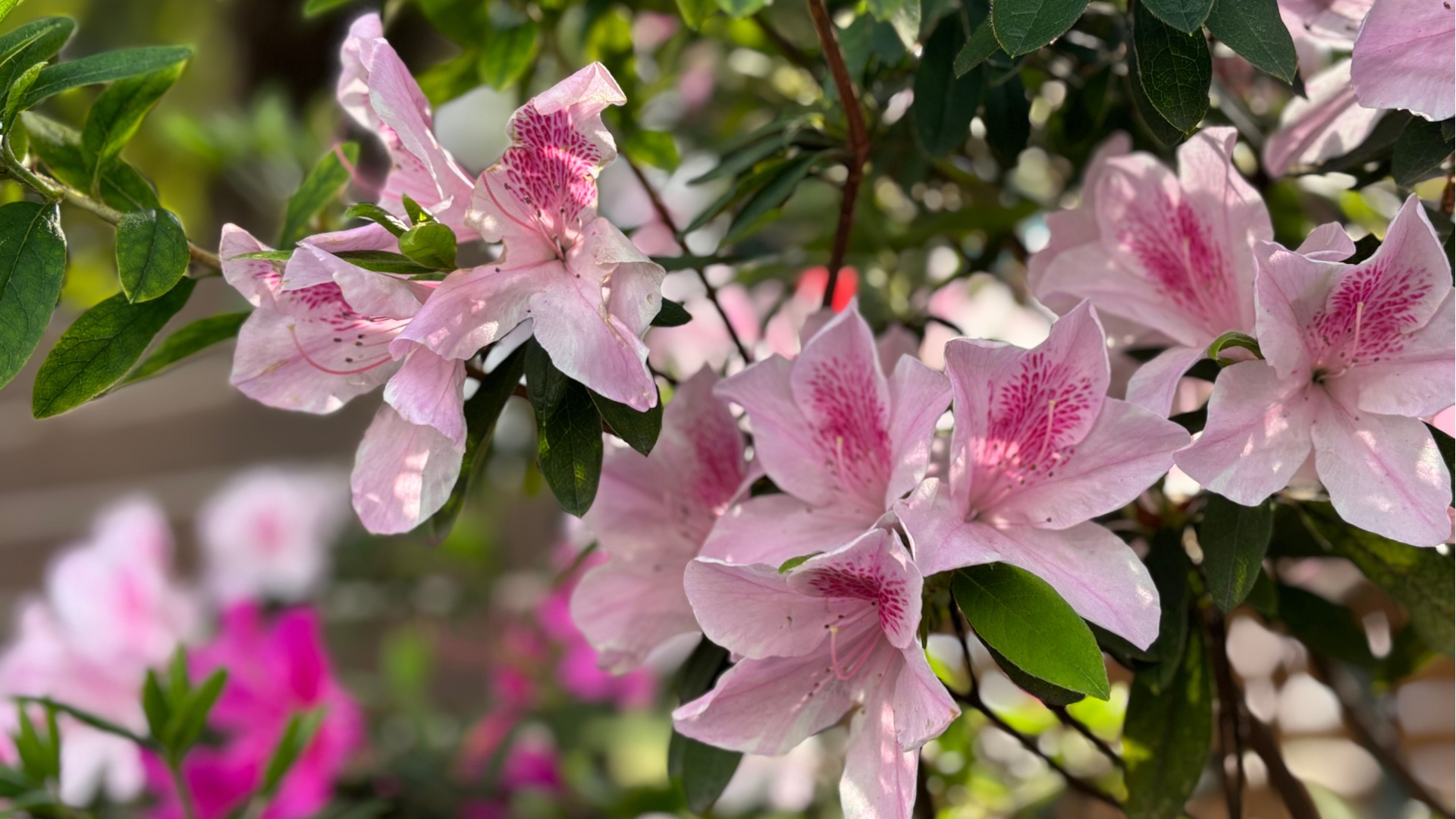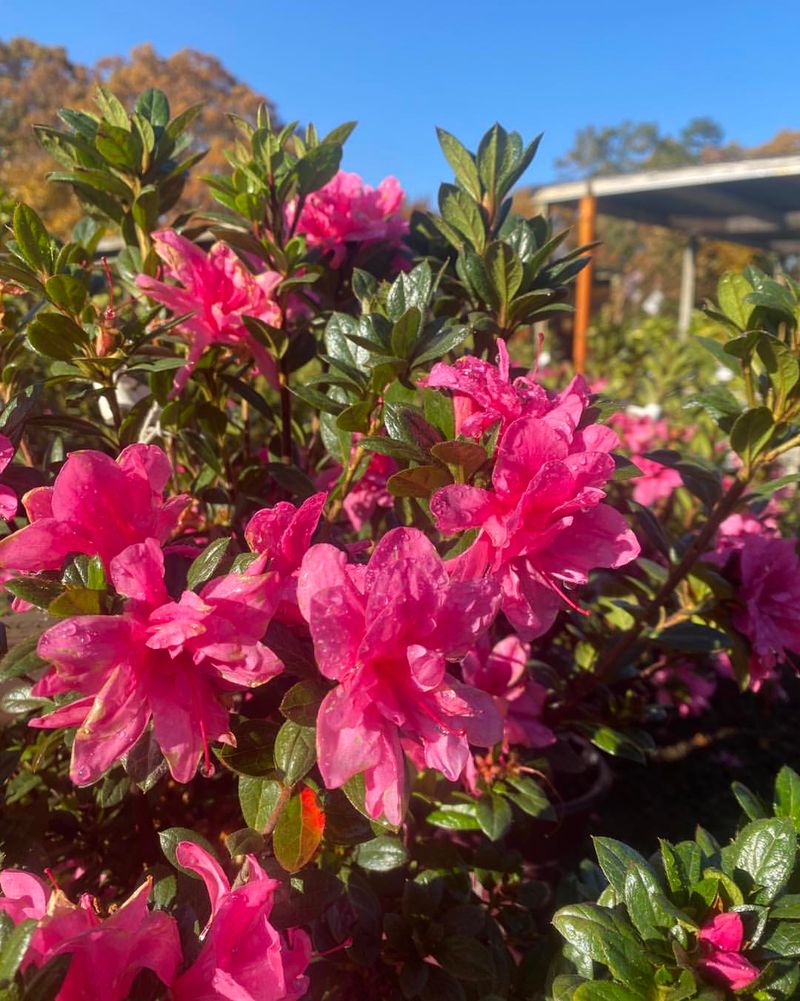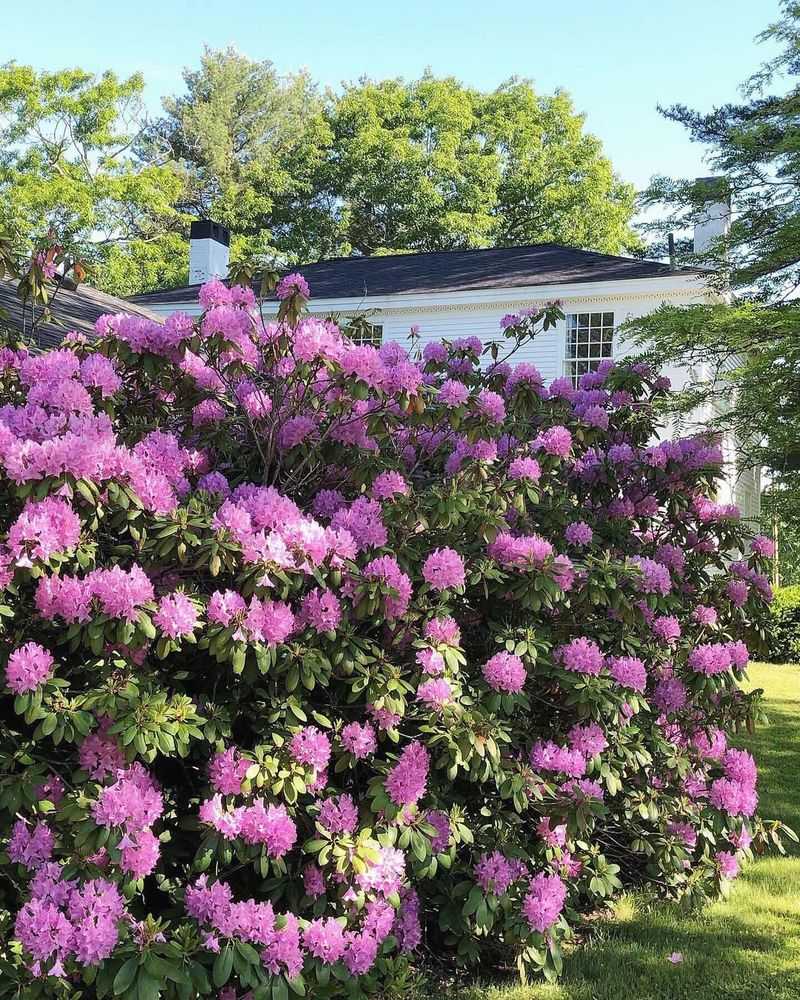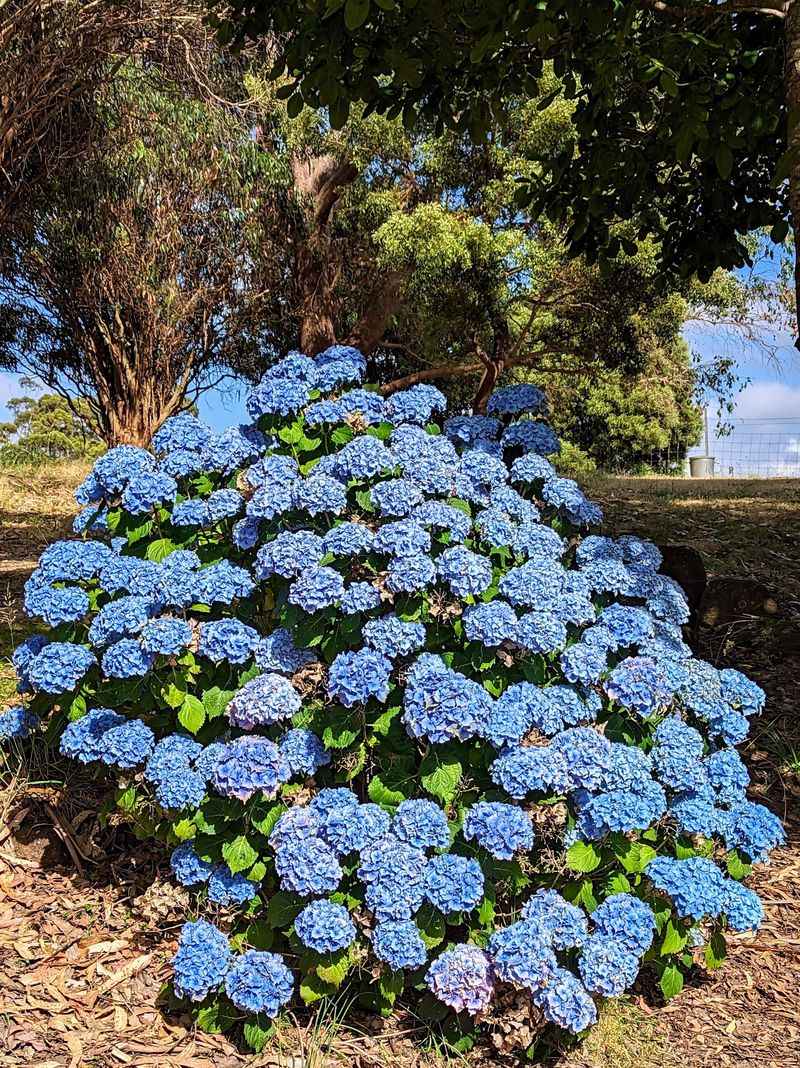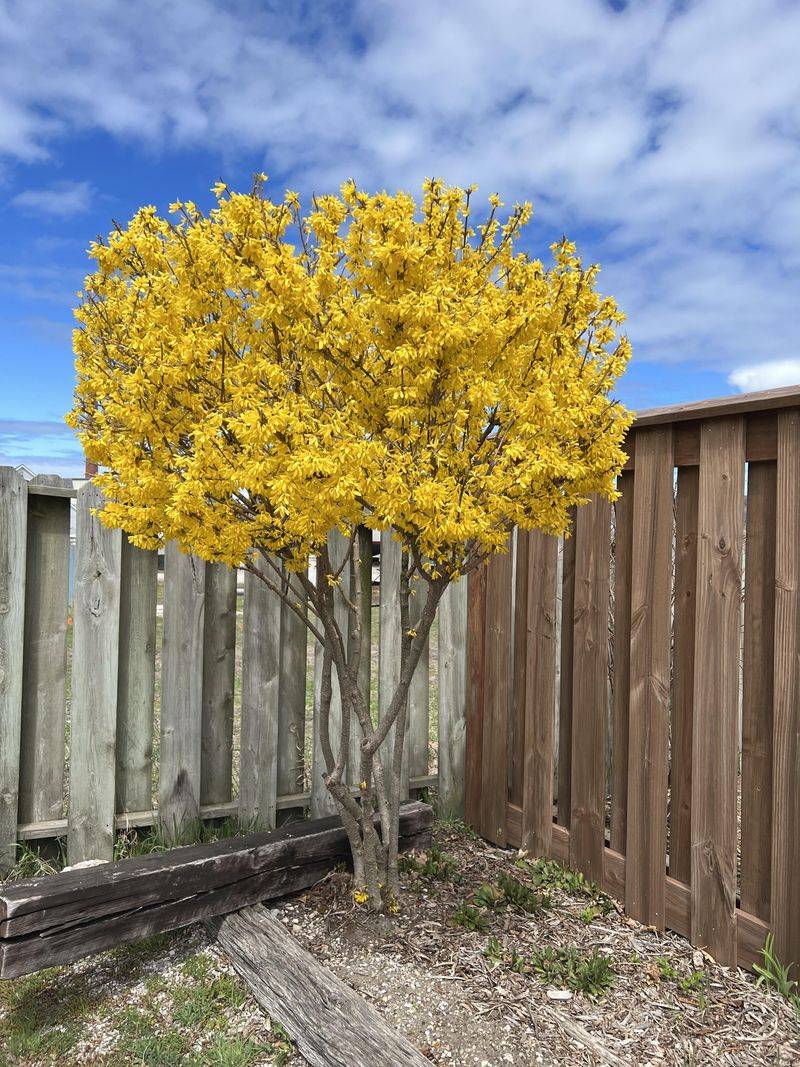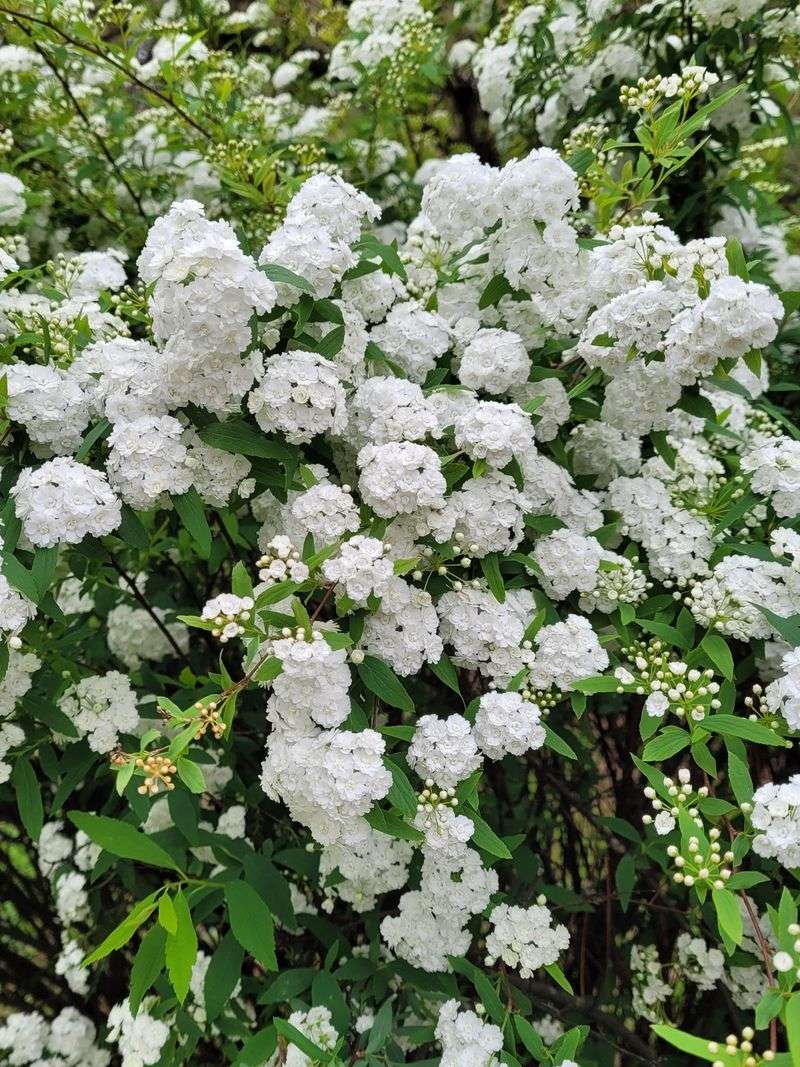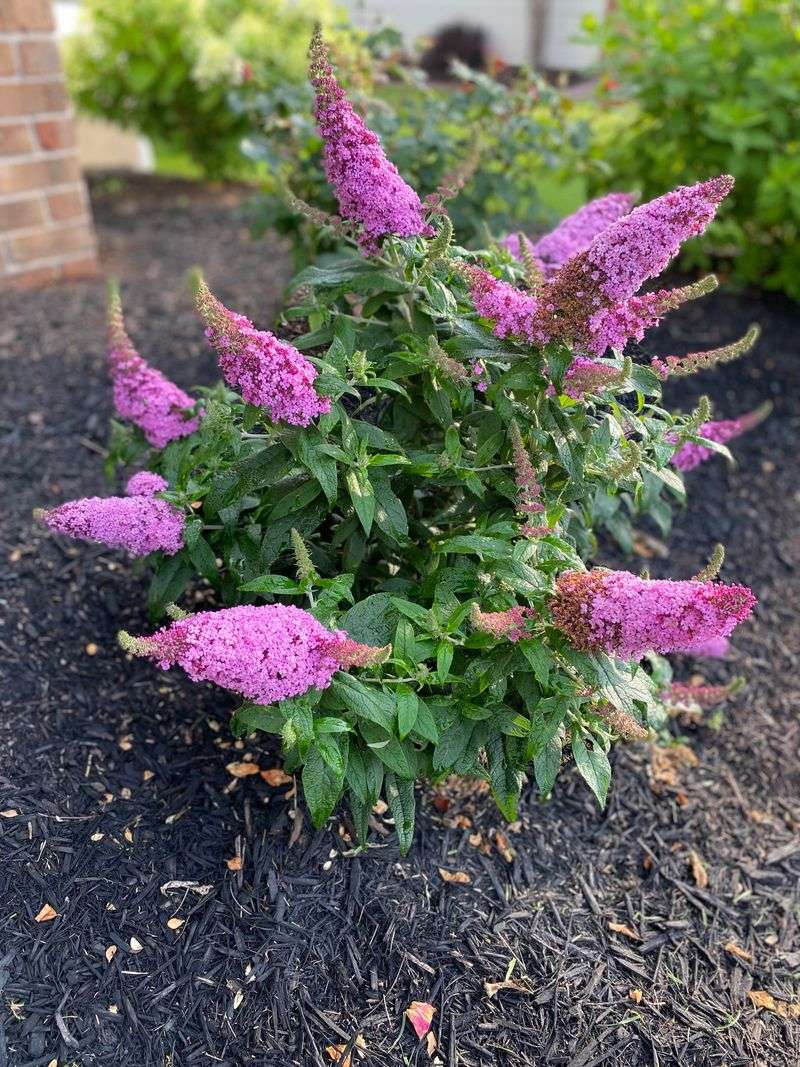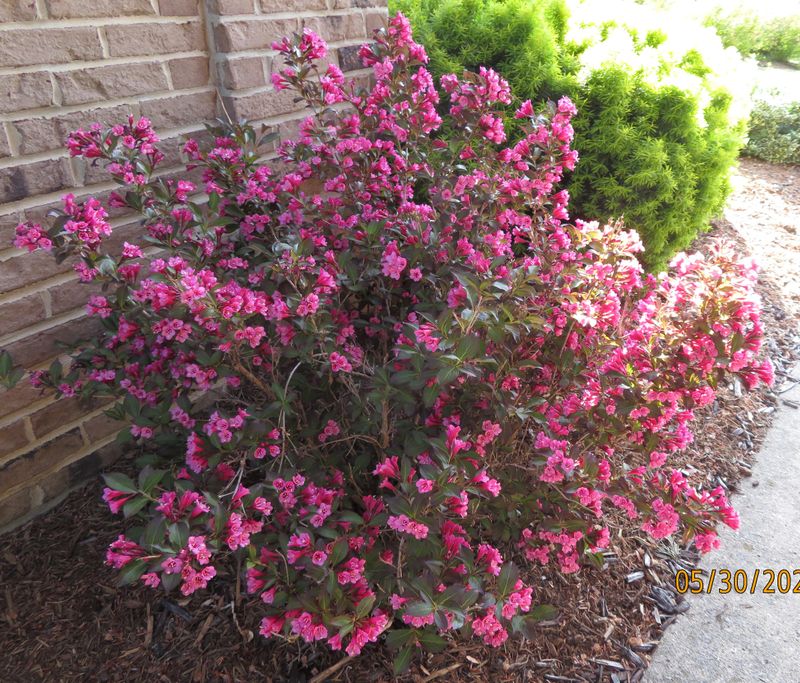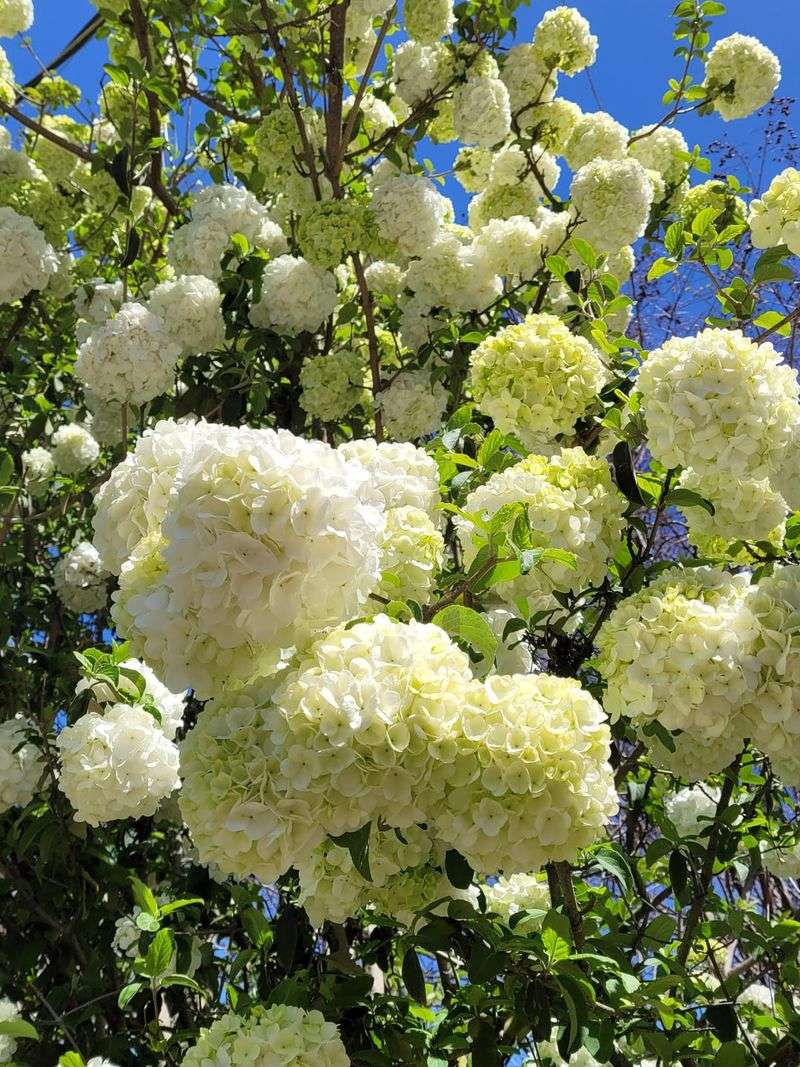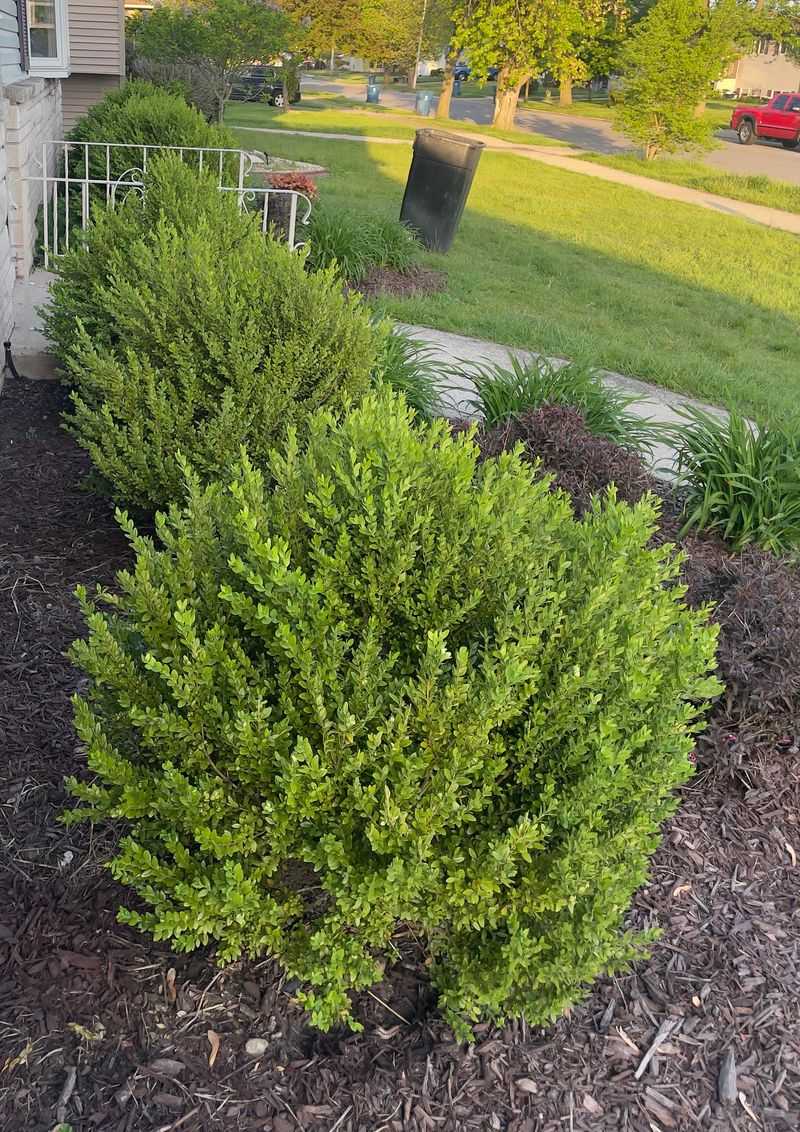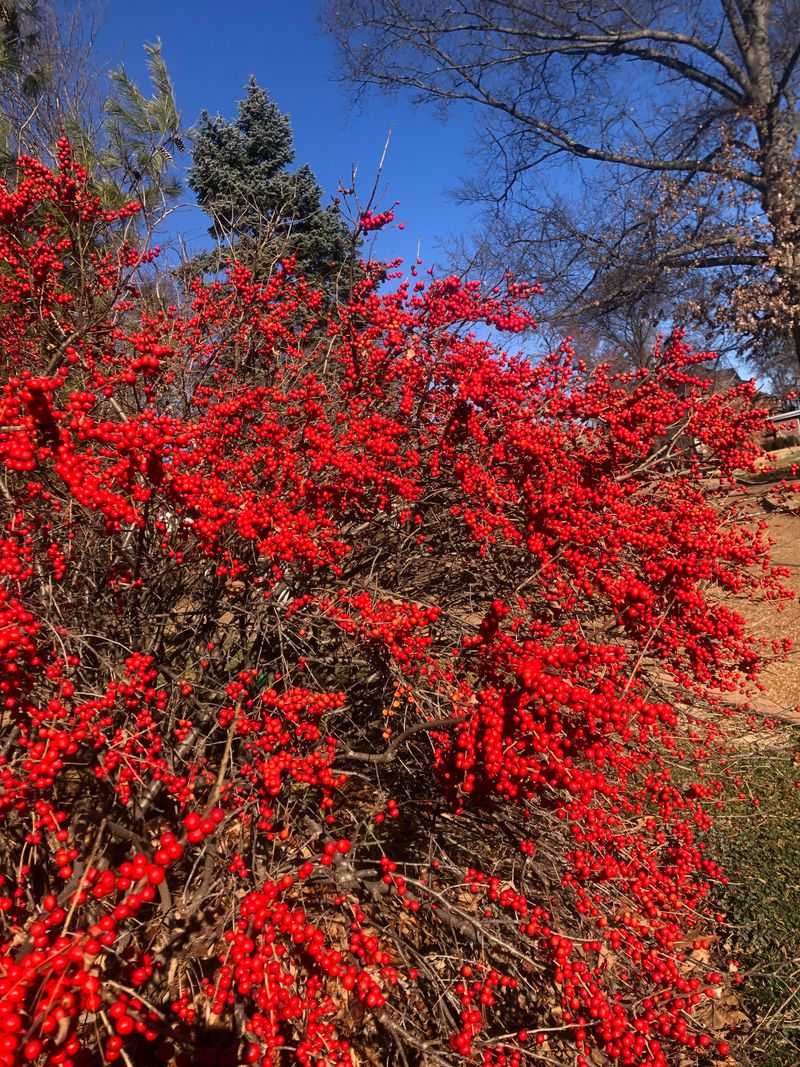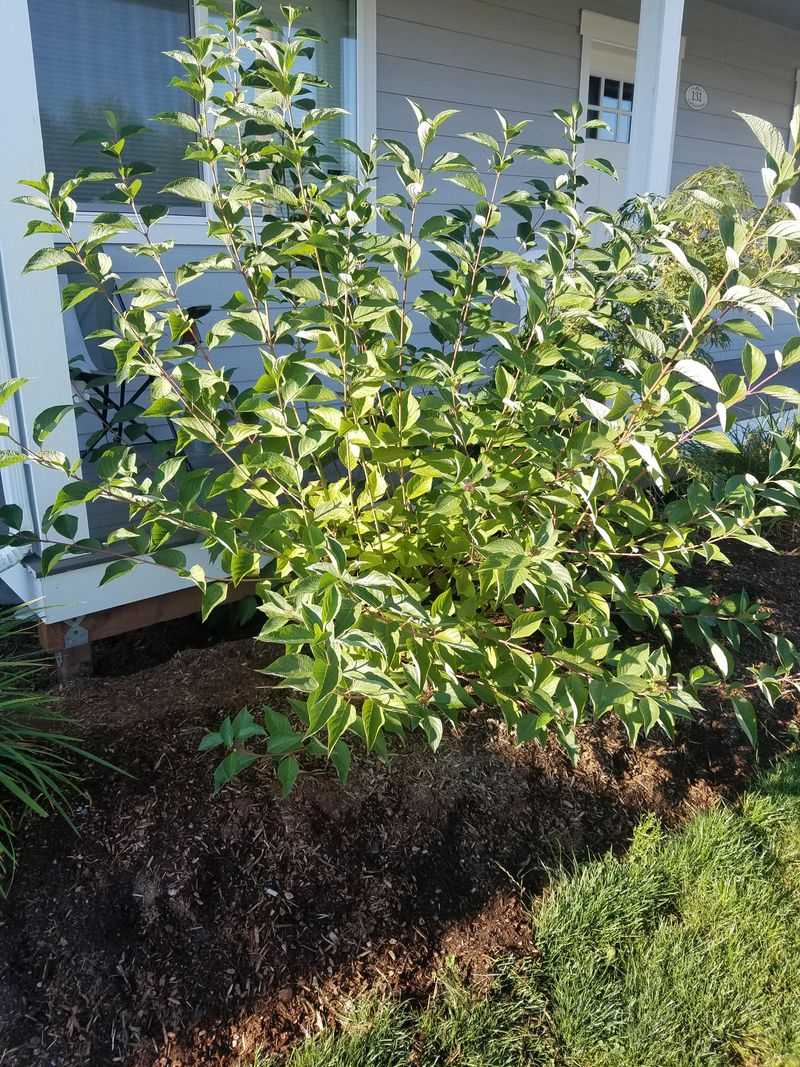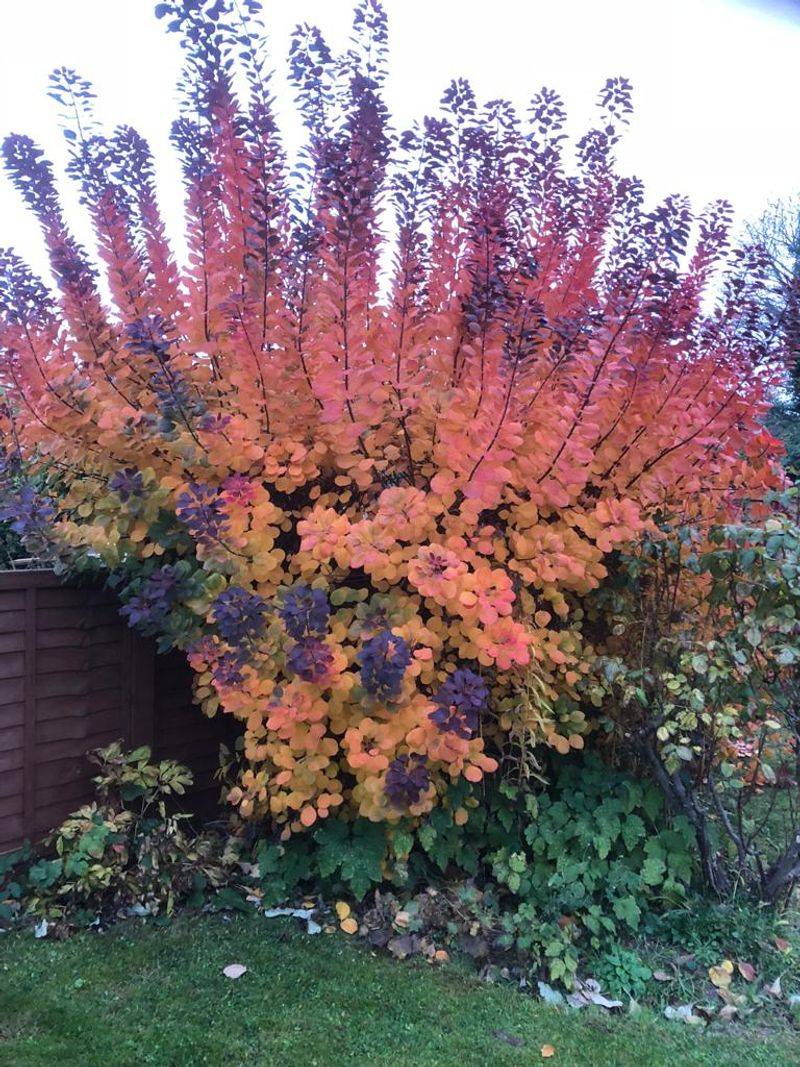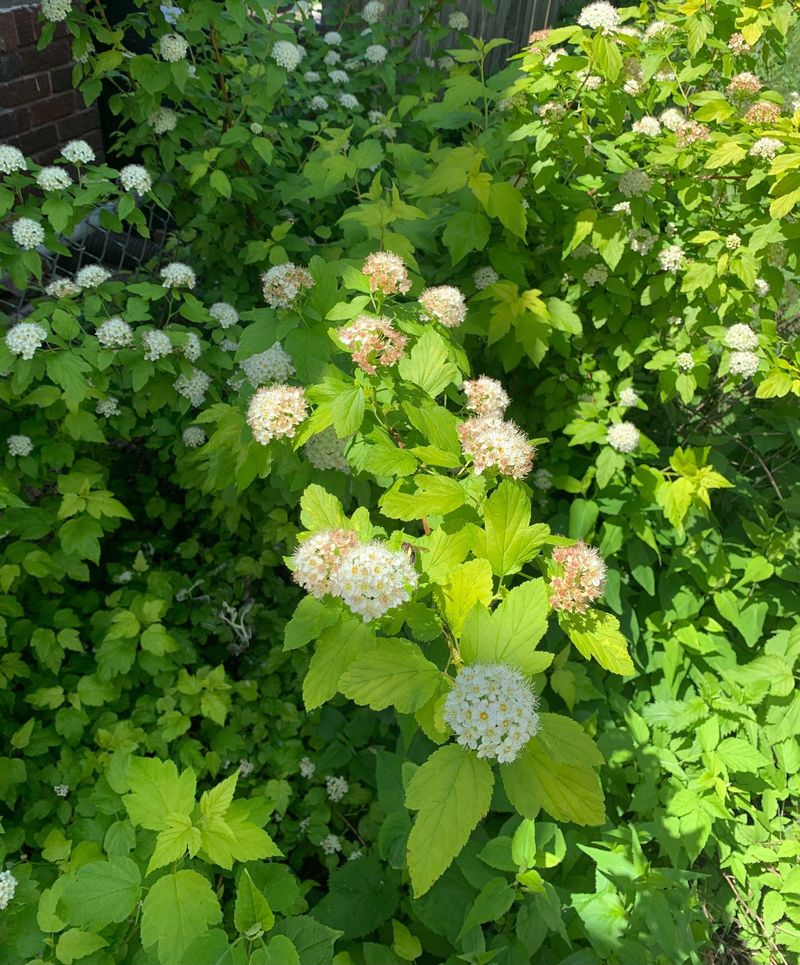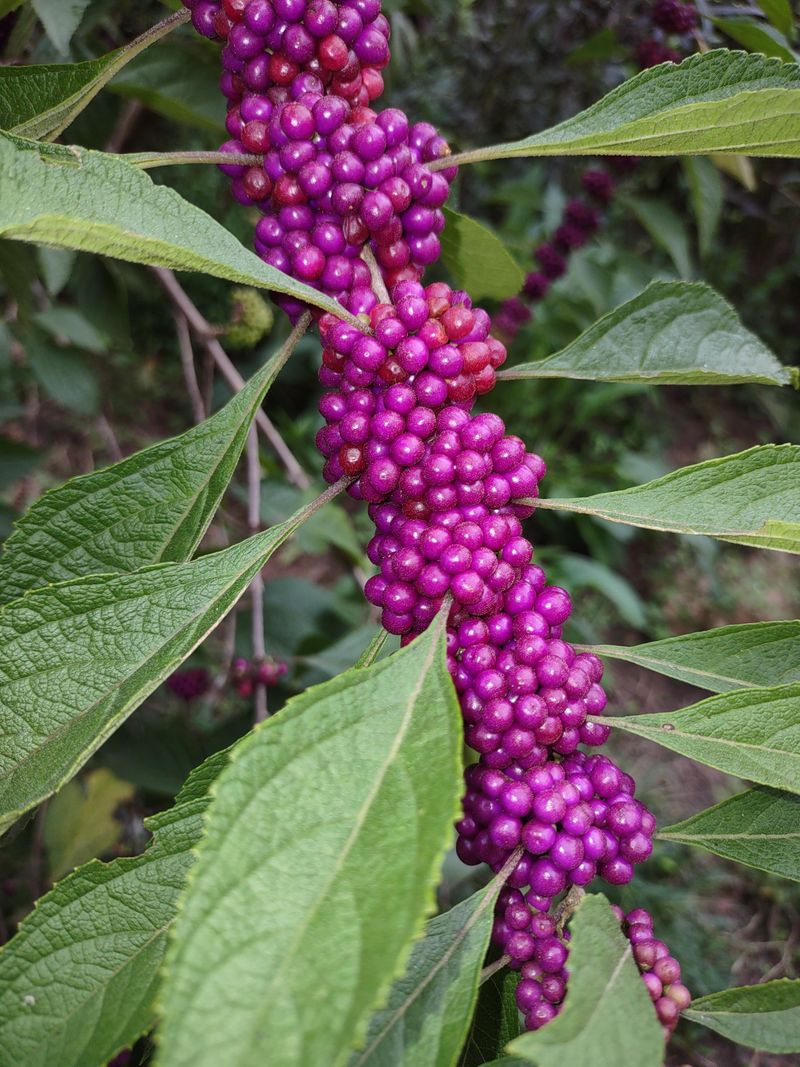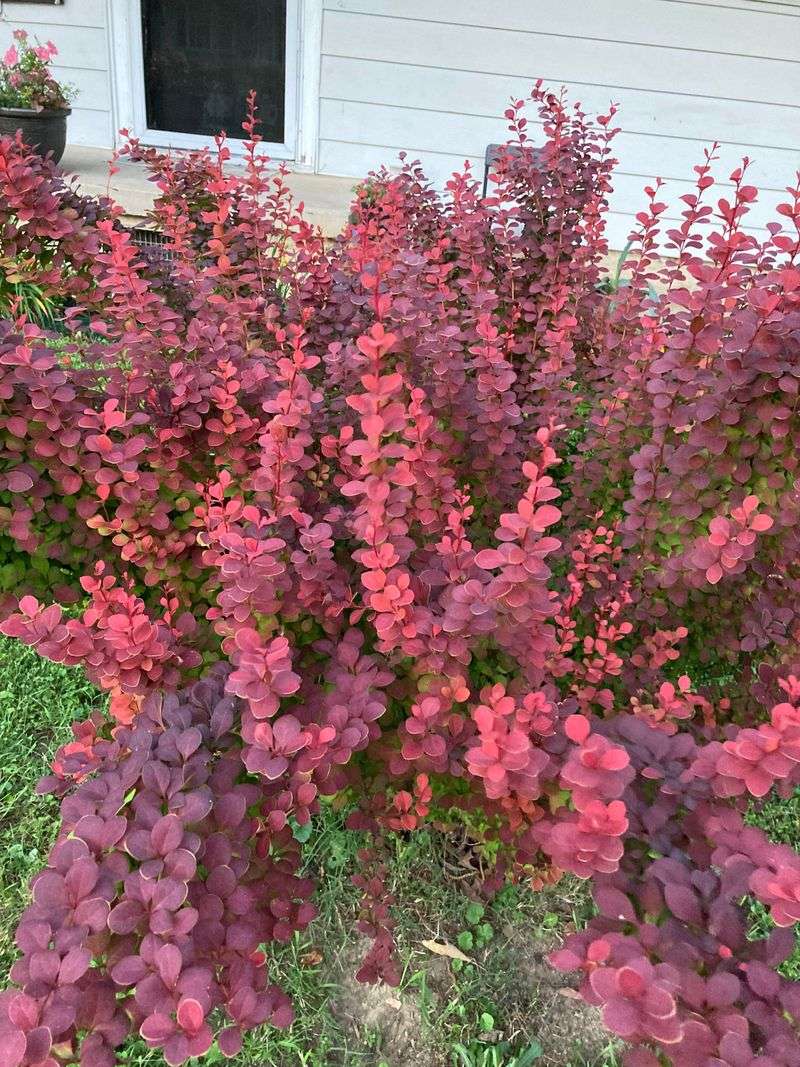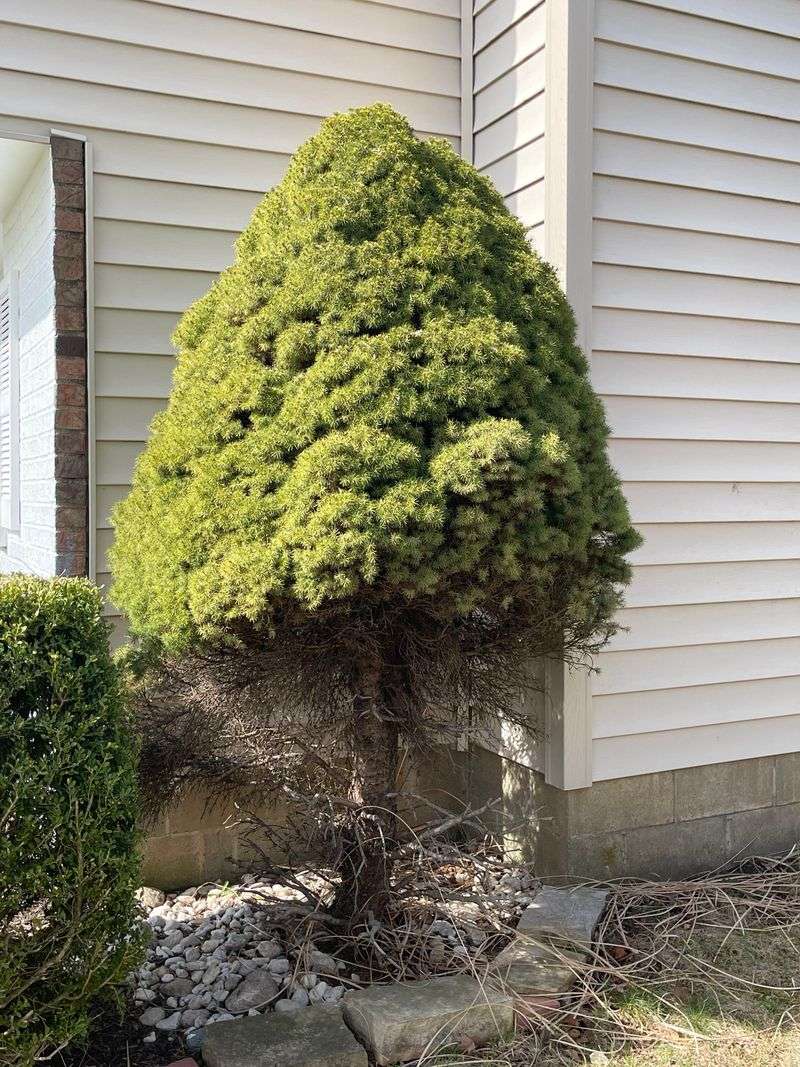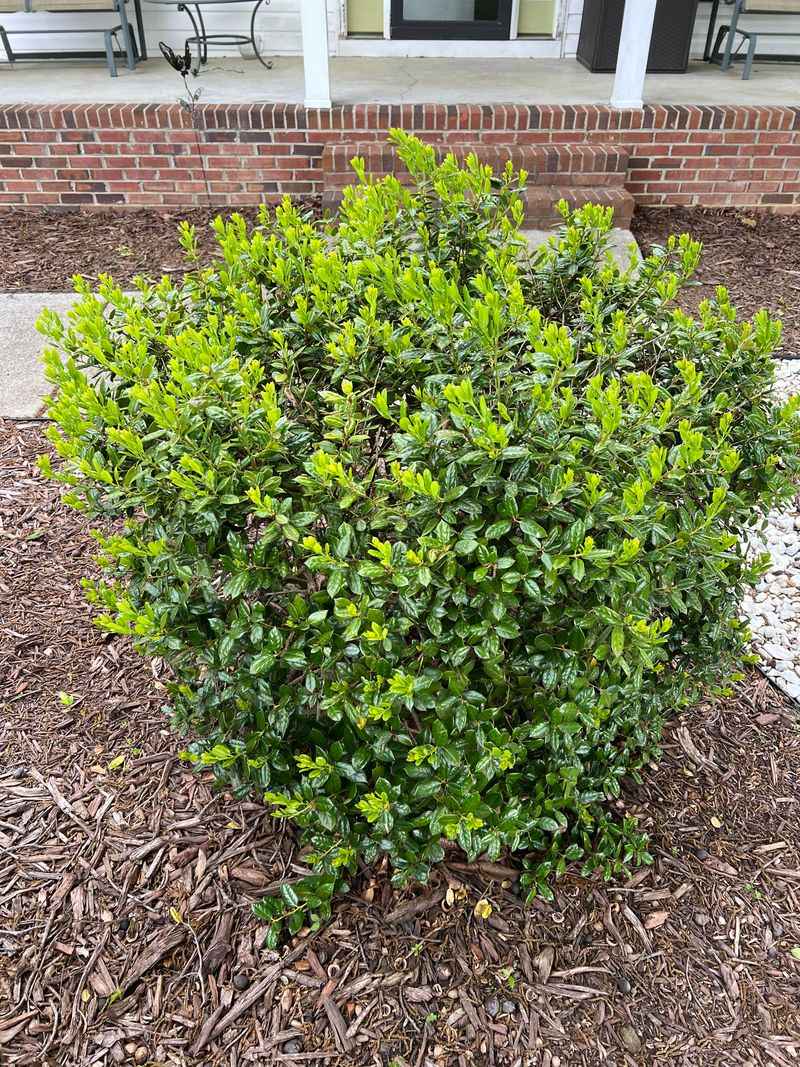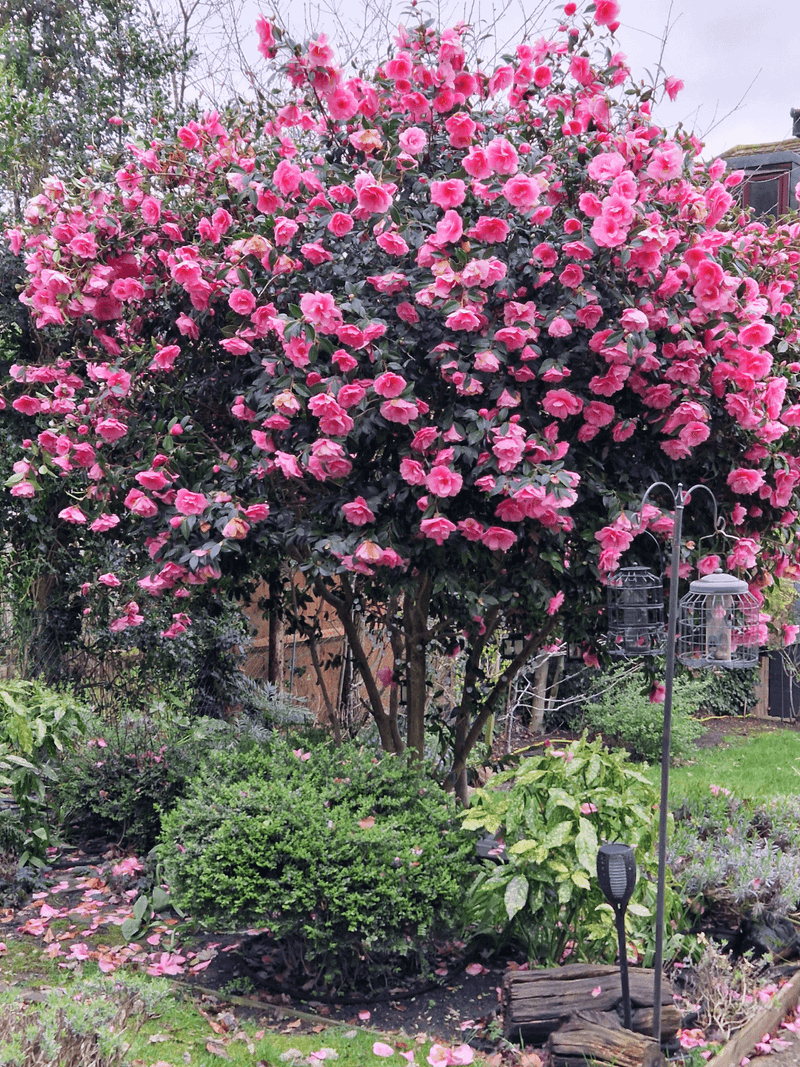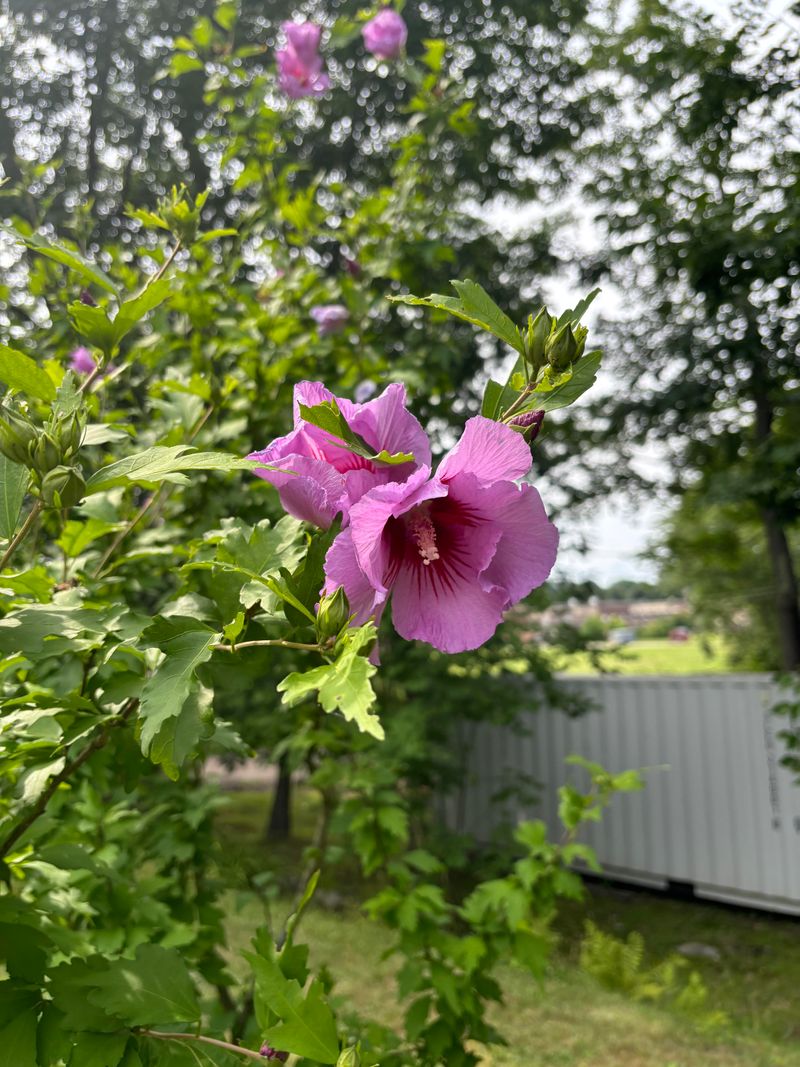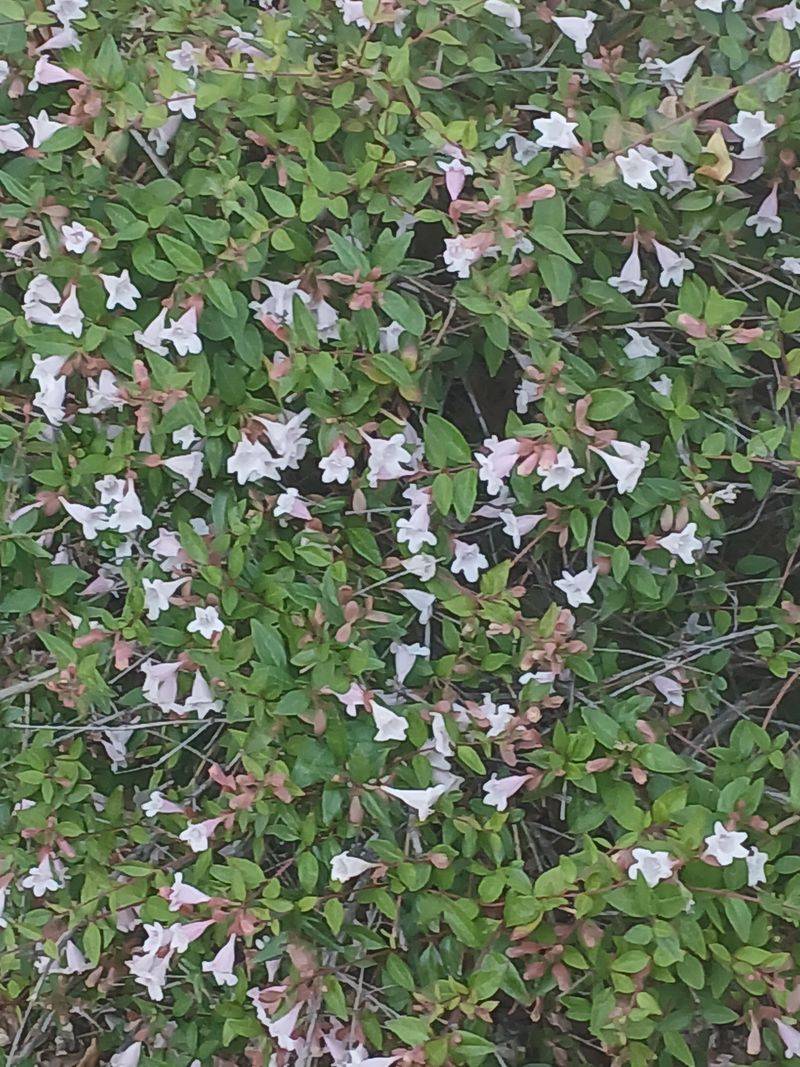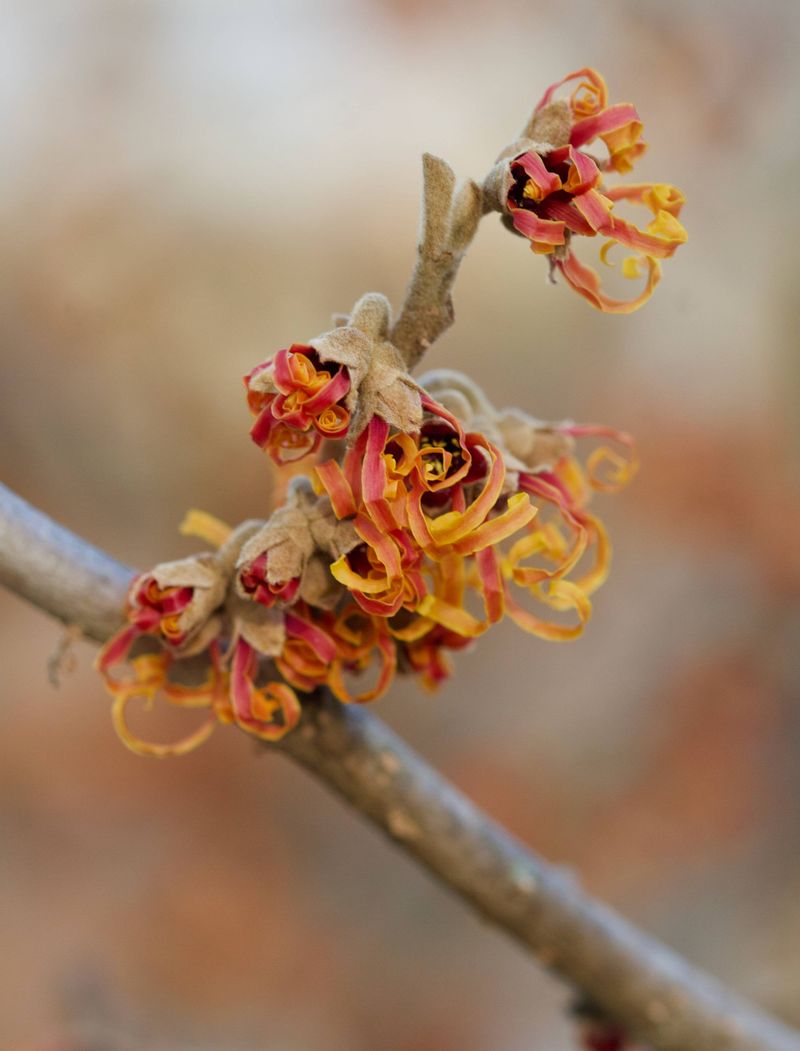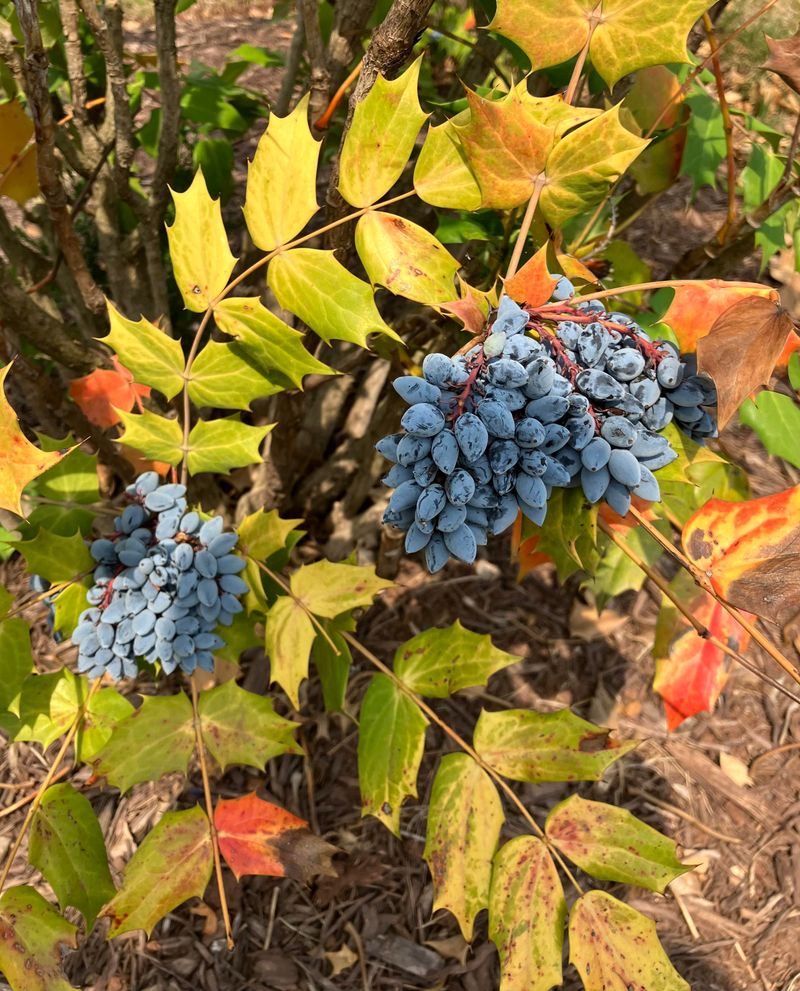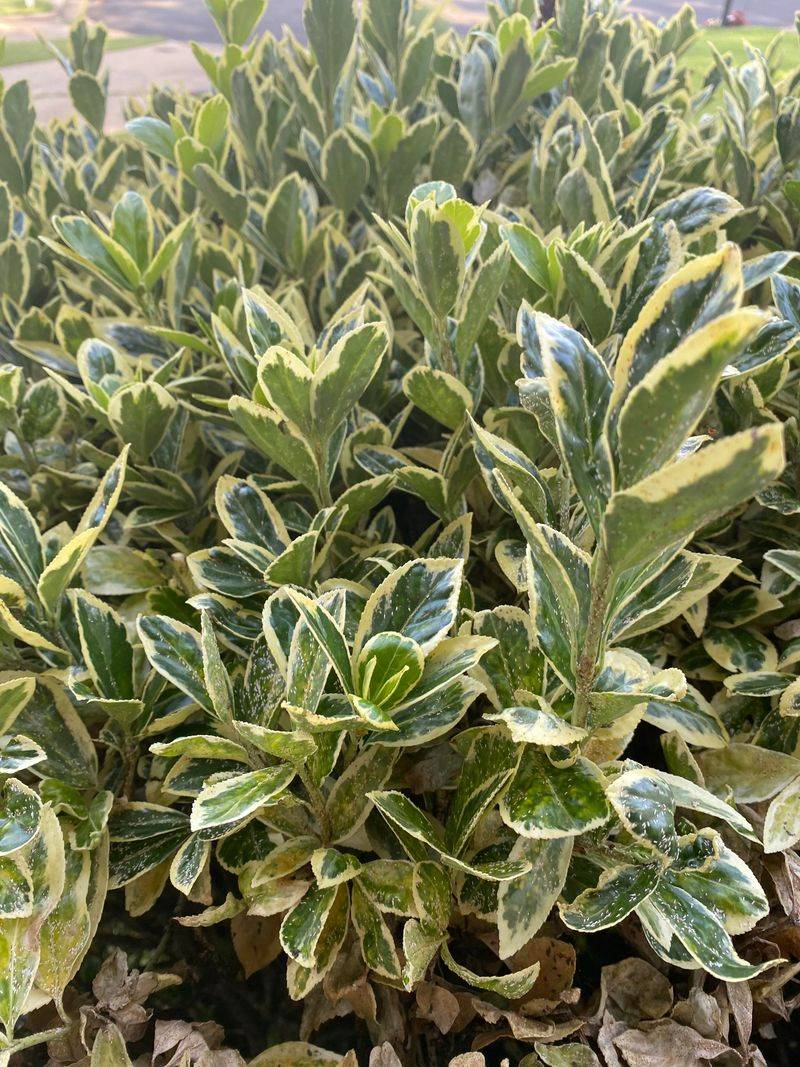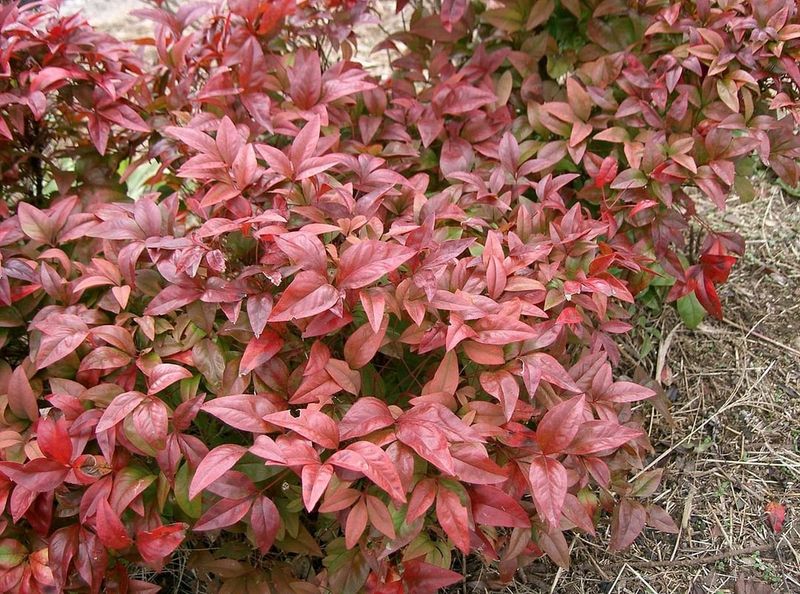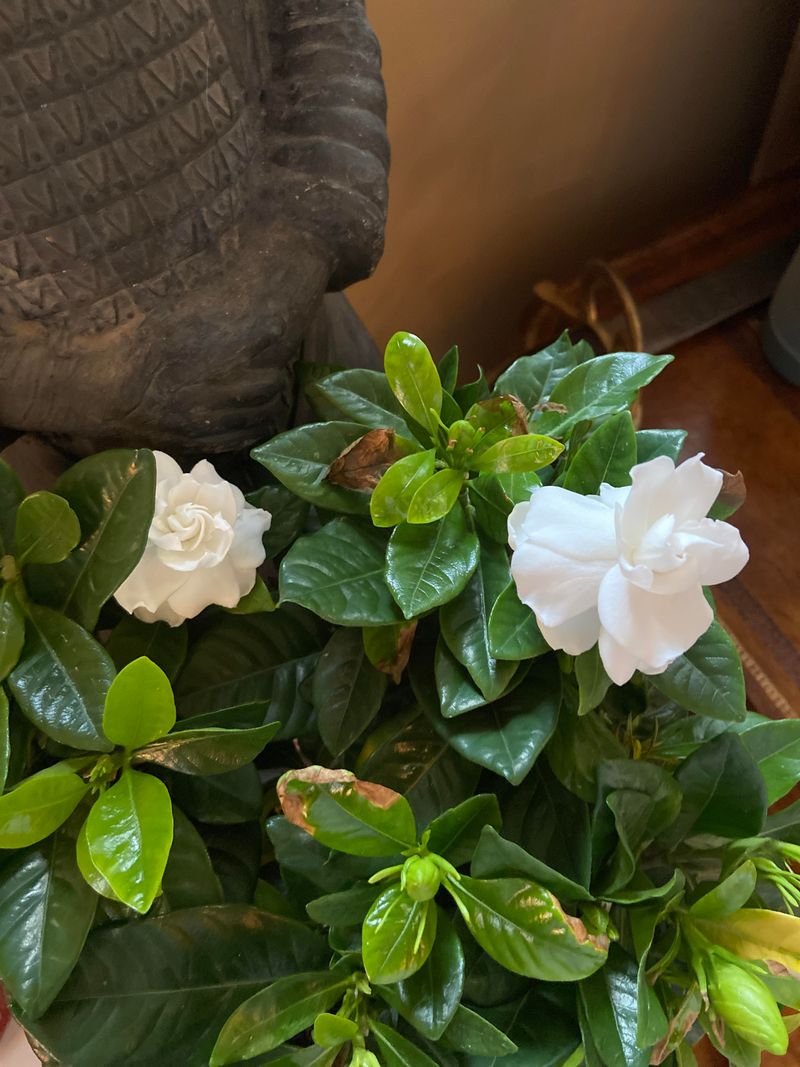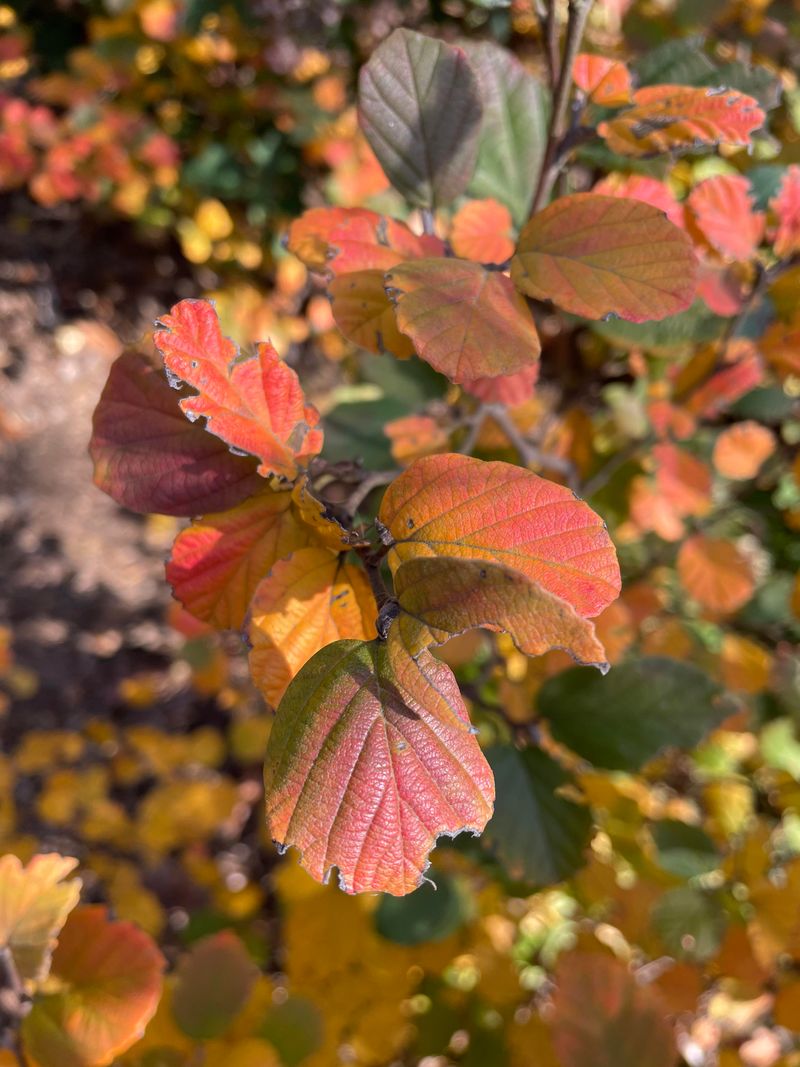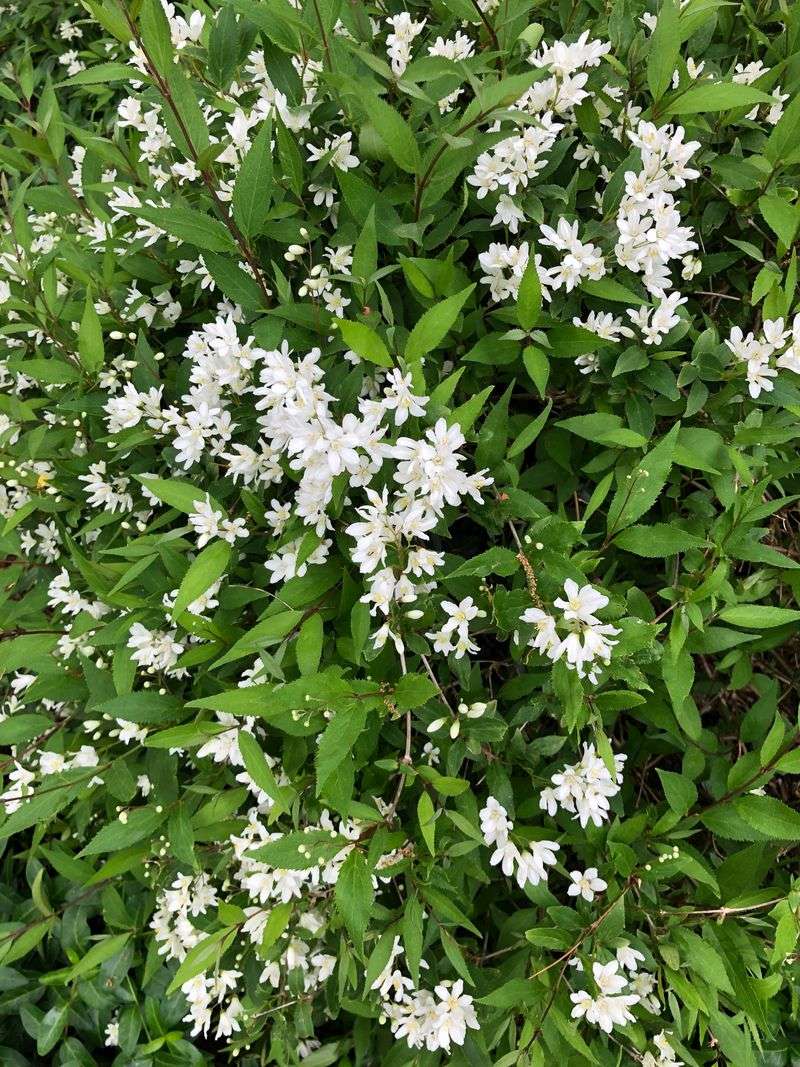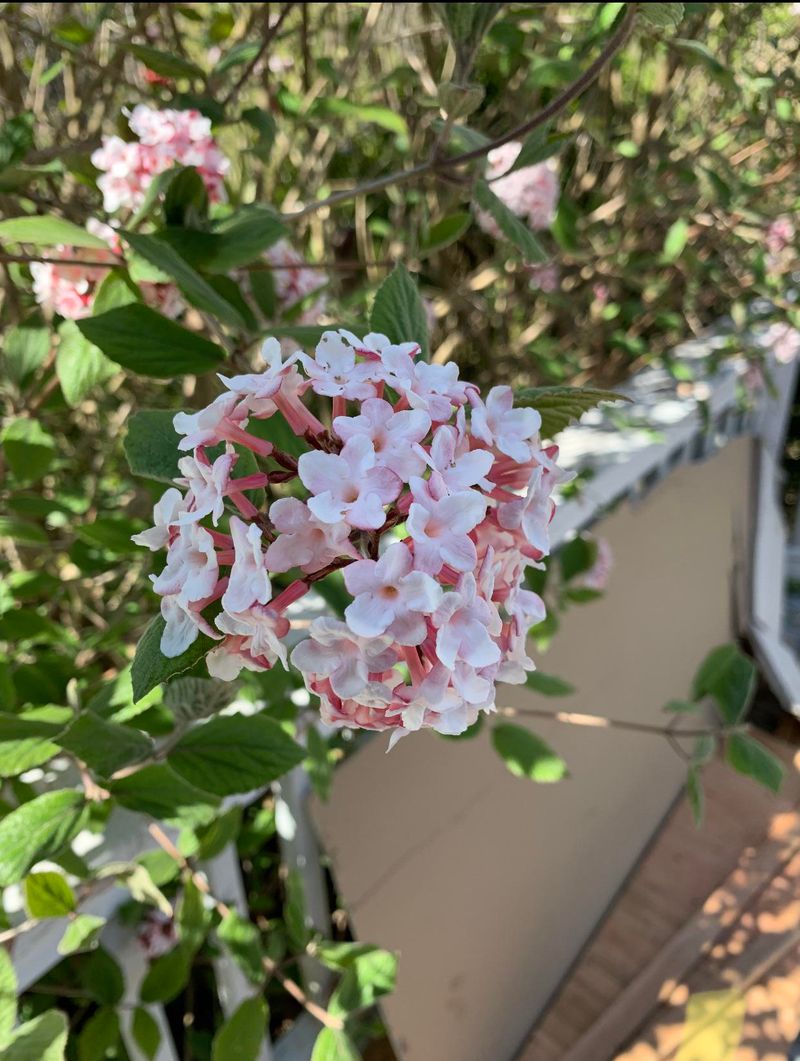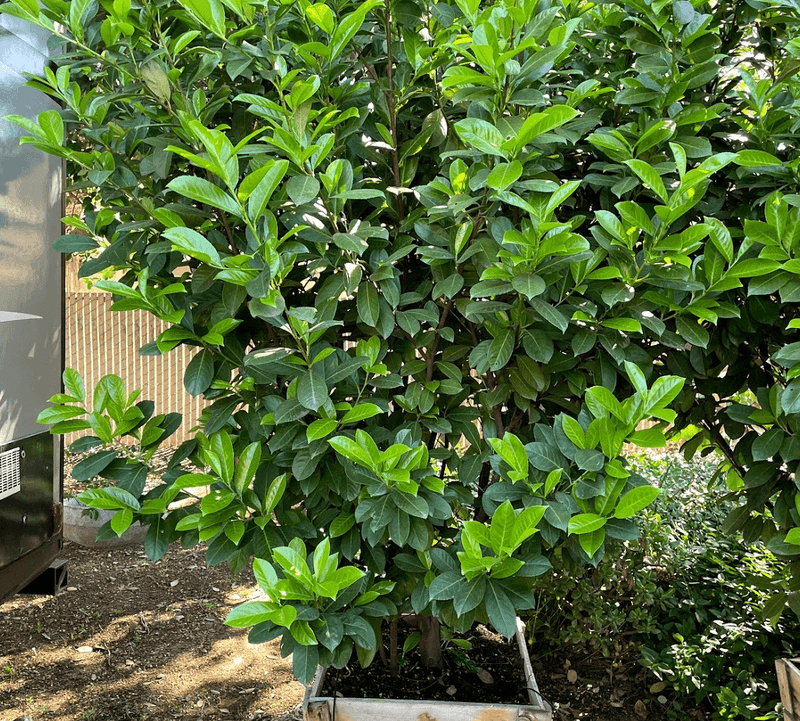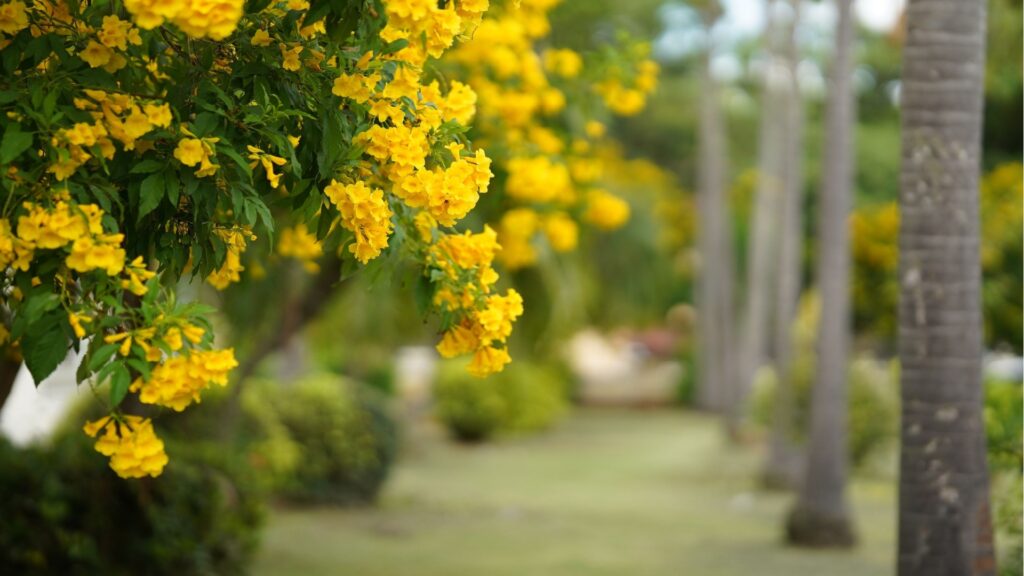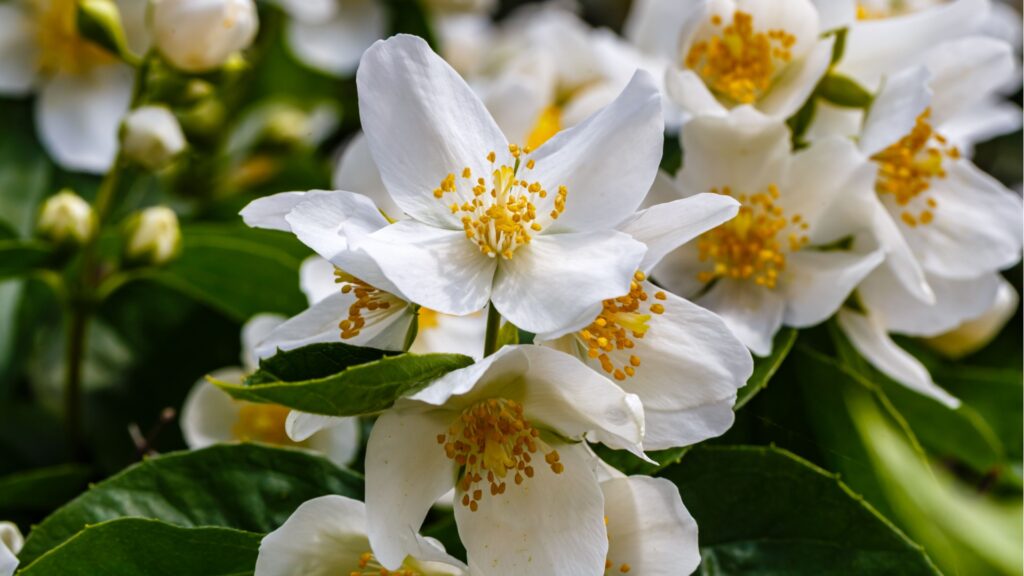Spring is nature’s cue to hit refresh—and there’s no better way to wake up your garden than with shrubs that shine in every season. From bold scene-stealers to quiet charmers, the right shrub can turn any patch of earth into a showstopper.
This guide rounds up 22 top picks (plus a few extras) to keep your garden bursting with color, texture, and interest all year long. Ready to plant the seeds of something beautiful? Let’s dig in.
1. Azalea
Azaleas bring a riot of spring color with their vibrant pink, red, purple, or white blooms. Their lush foliage stays green through much of the year, adding structure and interest to garden beds.
Plant azaleas in acidic, well-draining soil and partial shade for best performance. Keep the soil moist but not soggy, and mulch well to protect roots.
They’re perfect for woodland gardens, borders, or containers. With proper pruning after flowering, they’ll stay compact and colorful for years.
2. Rhododendron
Rhododendrons are showy evergreen shrubs with massive clusters of trumpet-shaped flowers in spring. Their bold leaves and dramatic blooms make them garden royalty.
They prefer dappled shade and acidic, well-draining soil rich in organic matter. Water consistently and avoid hot afternoon sun to prevent leaf scorch.
Use them as statement pieces or to create layered shrub borders. Once established, they’re hardy, low-maintenance, and stunning year-round.
3. Hydrangea
Hydrangeas are beloved for their huge, cloud-like flower heads in blues, pinks, whites, or purples. Their color-changing abilities based on soil pH make them garden chameleons.
Plant in well-drained, moist soil with morning sun and afternoon shade. Regular watering and occasional feeding will boost blooms.
Perfect for borders, foundation plantings, or as stunning cut flowers. Prune based on type—some bloom on old wood, others on new.
4. Forsythia
Forsythia bursts into bright yellow bloom in early spring, often before the leaves even appear. It’s a cheerful sign that winter’s over.
Plant in full sun for the best floral display, and give it room to spread. It’s drought-tolerant once established and loves well-drained soil.
Use it as a lively hedge or mixed in shrub borders for early color. Prune right after flowering to keep its shape in check.
5. Spirea
Spirea is a graceful, flowering shrub that blooms in cascades of white or pink from spring into summer. Its fine-textured leaves add a soft touch to landscapes.
It grows best in full sun and average, well-drained soil. Once planted, it’s tough, adaptable, and forgiving.
Prune after blooming to encourage a second flush of flowers. It’s perfect for low hedges, mixed borders, or mass plantings.
6. Butterfly Bush (Buddleia)
Butterfly Bush is a magnet for butterflies, bees, and hummingbirds with its fragrant, spiky blooms in purple, pink, or red. It blooms non-stop from summer to fall.
Plant in full sun and well-draining soil—it’s drought-tolerant and fast-growing. Prune hard in early spring to keep it tidy and encourage new blooms.
Best used in wildlife gardens, borders, or anywhere you want pollinator action. Just keep an eye on spread—some varieties can be invasive.
7. Weigela
Weigela delivers trumpet-shaped flowers in late spring to summer, often with a second bloom in fall. Its foliage can be green, bronze, or variegated, adding extra flair.
It grows well in full sun to light shade and average garden soil. Water regularly during its first year, then enjoy its low-maintenance nature.
Great for foundation plantings or mixed borders. It attracts hummingbirds and makes a vibrant, easy-care accent.
8. Viburnum
Viburnum shrubs are multitaskers—offering spring blooms, summer berries, and vibrant fall foliage. They range in size and form, so there’s one for every garden.
Plant in sun or part shade, in moist, well-draining soil. Some types are fragrant, and most are bird-friendly.
Use viburnum as a privacy screen, hedge, or specimen plant. Prune right after flowering to maintain its shape.
9. Boxwood
Boxwood is the go-to for formal hedges and tidy garden structure. Its dense, evergreen foliage can be shaped into anything from spheres to mazes.
Plant in well-drained soil and part sun to light shade. Avoid full afternoon sun in hot climates to prevent scorching.
Shear in spring or summer to maintain shape. It’s perfect for edging paths, creating low borders, or growing in elegant pots.
10. Winterberry (Ilex verticillata)
Winterberry brings dazzling red berries that persist through winter after its green leaves drop. It adds life to the landscape when little else does.
Plant both male and female plants in full sun and moist, acidic soil to get berries. It’s ideal for wetter spots in the garden.
Use it in mass plantings, as a seasonal screen, or as a winter focal point. Birds love the berries, and so will you.
11. Red-Twig Dogwood
This shrub shines in winter with vivid red stems that pop against snow or bare ground. In summer, it offers green leaves and white flowers.
It thrives in full sun to part shade and moist soil, even tolerating wet conditions. Prune older stems to keep the red color vibrant.
Perfect for winter interest, rain gardens, or naturalizing in open spaces. It’s tough, fast-growing, and always eye-catching.
12. Smokebush
Smokebush gets its name from the airy, smoke-like plumes that cover it in summer. Its deep purple or green foliage provides bold contrast all season.
It grows well in full sun and well-drained soil, and tolerates heat and drought once established.
Prune hard in early spring for vibrant foliage or let it grow tall for more flowers. It’s perfect for back borders, hedges, or as a bold focal point.
13. Ninebark (Physocarpus)
Ninebark’s peeling bark, colorful foliage, and frothy flowers make it a year-round stunner. It comes in various sizes and leaf colors from green to deep burgundy.
Plant in full sun for best color and in average, well-drained soil. It’s drought-tolerant and easygoing.
Use it as a hedge, foundation plant, or in native plantings. Prune lightly to maintain shape and encourage blooms.
14. Beautyberry (Callicarpa)
Beautyberry earns its name in fall when clusters of bright purple berries appear along its branches. It’s attractive year-round, especially to birds.
Plant in sun or partial shade and well-drained soil. Prune back hard in early spring for bushier growth.
Use it as a showpiece in the fall garden or mix into borders for berry contrast. Its graceful arching form adds softness and movement.
15. Barberry
Barberry offers colorful foliage in red, gold, or green along with tiny spring flowers and bright red berries. It’s thorny, dense, and great for security hedges.
Plant in full sun to get the best leaf color, and it’ll tolerate a range of soils. Prune lightly in spring to shape.
Use barberry for structure, color contrast, or a low-maintenance hedge. Just be aware—some types can be invasive.
16. Dwarf Alberta Spruce
This slow-growing evergreen forms a perfect cone shape without trimming. Its soft green needles and tidy size make it ideal for front doors or formal beds.
Plant in full sun and well-draining soil, and protect from strong winter winds. Water regularly during dry spells.
Great for containers, foundation plantings, or miniature landscapes. It brings reliable color and form all year long.
17. Holly (Ilex)
Holly is a classic evergreen shrub known for its glossy green leaves and bright red berries that shine in winter. Its spiny foliage adds texture and makes it a natural privacy barrier.
Plant holly in full sun to part shade with well-drained, slightly acidic soil. You’ll need a male and female plant nearby for berries.
It’s excellent as a formal hedge or festive accent. Birds adore the berries, and you’ll love the year-round color.
18. Camellia
Camellias bloom when almost nothing else does—late fall through early spring—offering lush flowers in pink, red, or white. Their glossy evergreen leaves keep things beautiful all year.
Plant them in dappled shade and acidic, well-draining soil. Protect from harsh afternoon sun and cold winds.
They’re stunning in woodland gardens, along shaded foundations, or in large pots. Water deeply and mulch well to keep roots cool and moist.
19. Rose of Sharon (Hibiscus syriacus)
Rose of Sharon is a summer bloomer that flaunts hibiscus-like flowers in bold shades of purple, pink, or white. It adds tropical flair to sunny gardens.
Plant in full sun and average soil; it’s heat- and drought-tolerant once established. Prune in early spring to shape and encourage strong blooming.
Use it as a flowering hedge, privacy screen, or focal point. Pollinators love it, and it blooms when others are fading.
20. Japanese Pieris
Japanese Pieris offers glossy foliage, spring flowers that resemble lily-of-the-valley, and fresh red growth in early spring. It’s elegant and evergreen.
Plant in acidic, well-draining soil with part shade—ideal beneath trees. Keep soil moist and mulch to retain moisture.
It works beautifully in foundation plantings or as a companion to azaleas and rhododendrons. Protect from harsh winter wind for best results.
21. Abelia
Abelia is a graceful shrub with arching branches, glossy leaves, and clusters of fragrant tubular flowers from spring through fall. Some varieties also offer colorful foliage.
Grow it in full sun to part shade with well-drained soil. It’s drought-tolerant once mature and needs little pruning.
Use it in borders, mass plantings, or as a soft hedge. It draws in bees and butterflies all season long.
22. Daphne
Daphne is small but mighty, loved for its intensely fragrant blooms in early spring. Its compact form and leathery leaves make it ideal for small spaces.
Plant in part shade and well-drained, humus-rich soil. It dislikes root disturbance, so plant it where it can stay.
Use near patios or entryways to enjoy the scent. Water regularly but don’t let soil stay soggy.
23. Witch Hazel
Witch Hazel lights up the garden with spidery yellow, orange, or red flowers in late winter when little else blooms. It also offers glowing fall foliage.
Plant in full sun to part shade and moist, acidic soil. It’s adaptable, hardy, and surprisingly tough.
Use it in mixed borders or as a seasonal highlight. Its unusual flowers bring welcome life to late winter days.
24. Sweetspire (Itea virginica)
Sweetspire is a native beauty with fragrant white flower spikes in summer and brilliant red-orange foliage in fall. It thrives in both wet and dry spots.
Grow it in sun or part shade and moist, fertile soil. It’s perfect for rain gardens and tough locations.
Use it as a low hedge, erosion control, or woodland accent. It naturalizes beautifully and adds year-round charm.
25. Mahonia
Mahonia offers a bold, tropical vibe with spiky, holly-like leaves and clusters of yellow blooms in late winter. Birds flock to its blue berries in spring.
Plant in part to full shade and moist, well-drained soil. It’s deer-resistant and great for tricky shade areas.
Use as an architectural specimen or informal hedge. It adds texture and color when most other plants are bare.
26. Euonymus
Euonymus is a versatile shrub with varieties in every shape, size, and color—from golden groundcovers to evergreen hedges. It’s incredibly easygoing.
Grow in full sun to part shade and average soil. It tolerates pruning, pollution, and even poor soil.
Use as edging, privacy screens, or bold color accents. Some types offer stunning variegation and climbing ability, too.
27. Nandina (Heavenly Bamboo)
Nandina isn’t bamboo, but its lacy foliage and upright habit give that graceful vibe. Its color changes through the seasons—green to red to brilliant scarlet.
Plant in sun to part shade and well-draining soil. It’s drought-tolerant, deer-resistant, and needs little maintenance.
Use it for year-round interest in borders or foundation beds. It looks great massed or as a specimen plant.
28. Gardenia
Gardenias are famous for their creamy white blooms and intoxicating fragrance. Their glossy evergreen leaves are just as striking.
They love acidic, well-drained soil and bright, indirect light. Protect from cold and keep humidity high.
Use gardenias in containers, near seating areas, or as foundation plants. With care, they’ll perfume your garden for months.
29. Fothergilla
Fothergilla is a hidden gem with fluffy white bottlebrush flowers in spring and stunning red, orange, and yellow foliage in fall.
It thrives in sun or part shade and acidic, moist soil. It’s low-maintenance and native to the U.S.
Use it in mixed shrub borders or native plantings. Its multi-season beauty makes it well worth a spot.
30. Deutzia
Deutzia is an underused spring bloomer with cascading white or pink flowers and arching stems. Some varieties offer red fall color too.
Plant in full sun and well-drained soil for best blooms. It’s fast-growing and thrives with minimal care.
Use in mass plantings, slopes, or informal hedges. Prune after flowering to keep its shape.
31. Korean Spice Viburnum
Korean Spice Viburnum lives up to its name with heavenly-scented pink-to-white blooms in spring. Its rounded form and red fall foliage add year-round appeal.
Plant in full sun to part shade and well-drained soil. It’s drought-tolerant once established and doesn’t need much pruning.
Perfect for near patios or paths where you can enjoy the scent. Birds love the berries that follow the flowers.
32. Laurel (Prunus laurocerasus)
Laurel is a dense, evergreen shrub with shiny green leaves and white flower spikes in spring. It’s tough, fast-growing, and great for screening.
Plant in full sun to shade and moist, well-drained soil. It tolerates pruning and adapts to urban or rural spaces.
Use as a hedge, windbreak, or privacy wall. It offers four-season structure and easy maintenance.
33. Kerria Japonica
Kerria Japonica brings a splash of cheerful yellow with its pom-pom-like blooms in mid to late spring. Its bright green stems offer color even in winter, making it a multi-season gem.
Plant in part shade to full sun and well-drained soil. It’s tolerant of poor soils and spreads easily, making it a great choice for naturalized areas.
Use it in woodland edges, informal borders, or as a soft hedge. Prune after flowering to encourage new growth and maintain its tidy arching shape.
34. Mock Orange
Mock Orange earns its name with sweet, citrusy-scented white blooms in late spring to early summer. Its lush growth and classic flower clusters add old-fashioned charm to the garden.
Plant in full sun to partial shade and well-drained soil. It’s adaptable, hardy, and generally low-maintenance once established.
Use near seating areas or windows to enjoy the fragrance. Prune right after flowering to shape and rejuvenate older stems.

